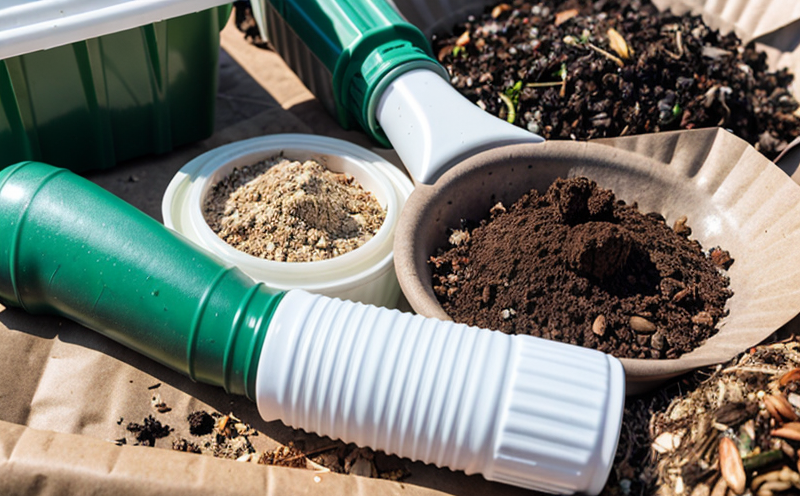ISO 18606 Packaging Recovery through Composting and Biodegradation
The ISO 18606 standard is a cornerstone in the evaluation of packaging materials designed to be recovered through composting. This service ensures that materials meet stringent biodegradability requirements, confirming their ability to break down into natural elements within specified conditions. Understanding this service requires a detailed look at its application and significance.
The ISO 18606 standard is particularly relevant for sectors dealing with waste management and recycling, especially those focused on organic and compostable materials. Packaging that passes the ISO 18606 test can be marketed as suitable for home or industrial composting, thereby contributing to reducing landfill waste and promoting circular economy principles.
The primary focus of this service is the degradation rate and biodegradation characteristics of packaging under defined composting conditions. This includes assessing how quickly a material breaks down into natural components such as carbon dioxide, water, and biomass within 28 days or less at specified temperatures (58°C). Compliance with ISO 18606 ensures that materials are genuinely sustainable and can contribute to environmental goals.
For packaging intended for composting, the test involves placing a defined quantity of material in a specially designed reactor filled with controlled amounts of water, air, and soil. The conditions mimic those found in industrial compost facilities, ensuring real-world relevance. This process is conducted under ISO 18606:2013 (E) which specifies the methods for determining biodegradation by quantifying CO2 evolution.
The service also involves detailed specimen preparation to ensure accurate testing results. Materials are cut into standardized pieces and conditioned to a specific moisture content before being introduced into the composting reactor. This ensures that all samples undergo identical initial conditions, enhancing comparability.
| Parameter | Description |
|---|---|
| Biodegradation Rate | The percentage of material mass lost through biodegradation within a specified time frame (usually 28 days). |
| CO2 Evolution | The amount of carbon dioxide produced from the degradation process. |
Once testing is complete, the results are reported in terms of biodegradation rate and CO2 evolution. These metrics provide a clear picture of how well the packaging material meets the criteria set forth by ISO 18606. This information is invaluable for quality managers, compliance officers, R&D engineers, and procurement teams who need to ensure their products align with sustainability goals.
The importance of this service cannot be overstated in an era where environmental consciousness is paramount. By ensuring that packaging materials meet stringent biodegradability requirements, we contribute to a more sustainable future. This service helps clients navigate regulatory landscapes and build trust with consumers who value eco-friendly products. It also aids in developing innovative solutions for waste management and recycling.
Why It Matters
The ISO 18606 Packaging Recovery through Composting and Biodegradation service is crucial because it helps companies meet regulatory requirements while promoting sustainable practices. Regulatory compliance ensures that products are safe for both the environment and human health, which is critical in waste management and recycling sectors.
- Compliance with ISO 18606 guarantees that packaging materials can be effectively composted under controlled conditions, reducing landfill waste.
- This service helps companies develop products that align with consumer demand for eco-friendly options, enhancing brand reputation.
The use of this service also supports the circular economy by ensuring that packaging materials are reused or recycled in a manner that minimizes environmental impact. By promoting the recovery and biodegradation of packaging through composting, ISO 18606 helps reduce greenhouse gas emissions and conserve natural resources.
Moreover, this service fosters innovation within the waste management sector by encouraging the development of new materials and processes that are more sustainable. It provides a benchmark for evaluating the performance of different packaging solutions, allowing companies to make informed decisions about which products best meet their sustainability goals.
Scope and Methodology
The scope of ISO 18606 Packaging Recovery through Composting and Biodegradation encompasses the evaluation of packaging materials designed for composting. The methodology involves a series of controlled tests to assess biodegradability under specified conditions.
| Parameter | Description |
|---|---|
| Sample Preparation | Standardized cutting and conditioning to ensure uniform moisture content. |
| Composting Conditions | Temperature, humidity, and aeration levels mimicking industrial composting facilities. |
The testing process involves placing the prepared samples in reactors filled with controlled amounts of water, air, and soil. The CO2 evolution is measured at regular intervals to determine biodegradation rates. Compliance with ISO 18606 requires a minimum 70% mass loss after 28 days under these conditions.
This methodology ensures that the results are consistent and reliable, providing clear evidence of the material's compostability and biodegradability. It also allows for the comparison of different materials within an industry or across sectors, facilitating informed decision-making by manufacturers and regulators.
Environmental and Sustainability Contributions
- Reduction in Landfill Waste: By ensuring that packaging materials can be composted, this service helps reduce the amount of waste sent to landfills. This reduction contributes to a more sustainable environment.
- Emission Reduction: The biodegradation process captures and releases CO2, which is a natural part of the carbon cycle. Reducing the need for landfilling minimizes methane emissions, a potent greenhouse gas.
The service also contributes to resource conservation by promoting the reuse or recycling of materials that can be composted. This reduces the demand for raw materials and decreases energy consumption associated with manufacturing new products from virgin resources.
- Consumer Trust: By offering packaging that meets ISO 18606 standards, companies can build trust with environmentally conscious consumers who value sustainable practices.
- Innovation Stimulation: The service encourages the development of new materials and processes that are more sustainable. This fosters a culture of innovation within waste management and recycling sectors.
The environmental and sustainability contributions of this service extend beyond immediate benefits to long-term ecological health. By promoting compostability, we contribute to a circular economy where resources are used efficiently and waste is minimized.





